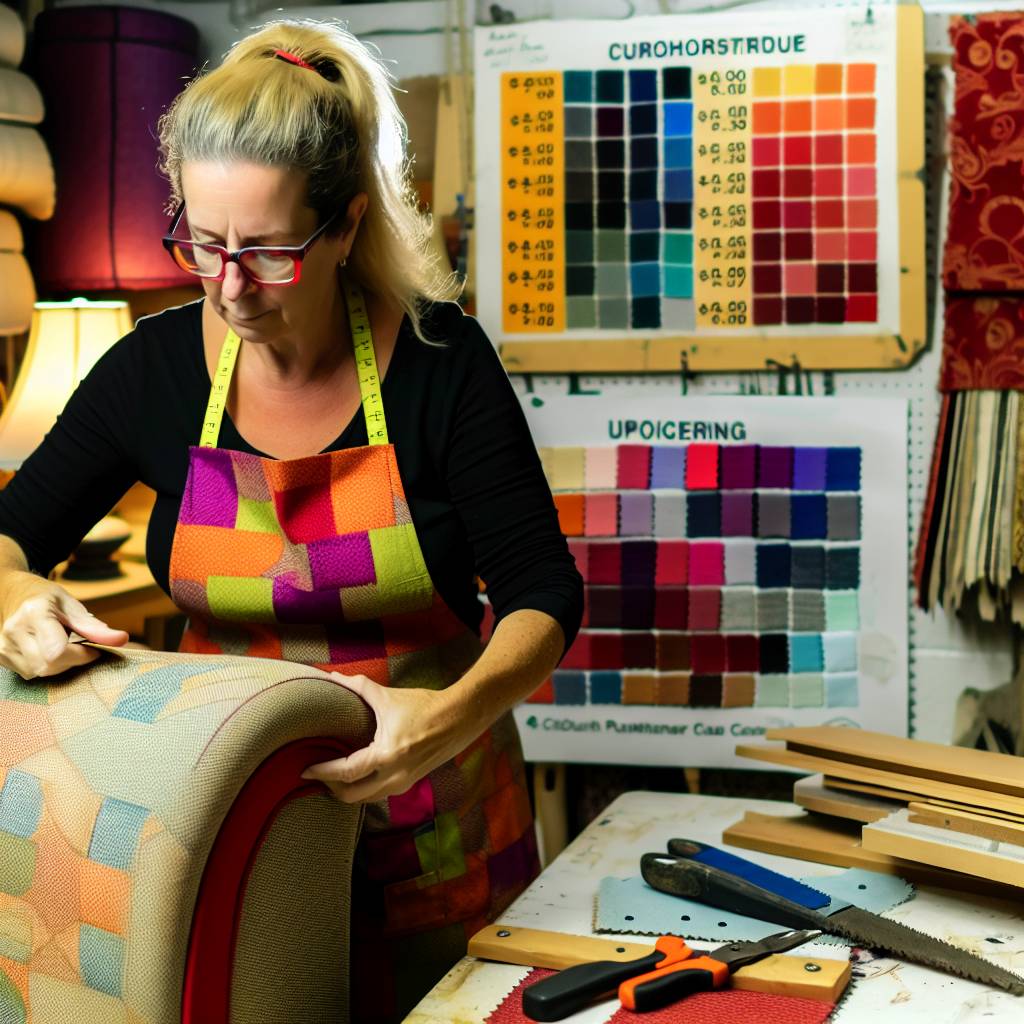Understanding the Cost of Materials
A Breakdown of Upholstery Supplies
Pricing your work as an upholsterer begins with understanding material costs.
Quality materials can significantly impact your final pricing.
First, consider the types of fabrics used in upholstery projects.
Natural fabrics like cotton and linen often cost more than synthetic options.
Next, think about durability and maintenance needs.
Higher-quality materials generally offer better longevity and ease of care.
In addition, upholstery foam is another critical component.
Choose the right density and thickness for optimal comfort and support.
Foam quality can vary greatly, impacting both price and performance.
Additional Supplies and Tools
Don’t forget other essential materials, such as batting, webbing, and springs.
Each of these components contributes to the overall cost of a project.
For instance, high-density batting improves comfort and firmness.
Webbing and springs affect both feel and durability.
- Webbing provides support for the seating area.
- Springs contribute to the overall bounce and comfort level.
Furthermore, hardware costs, such as staples and nails, should also factor in.
Quality tools, like sewing machines and staple guns, are necessary investments.
Consider these tools when budgeting for your pricing.
Determining Your Variable Costs
After assessing material costs, identify your variable expenses.
Labor, overhead, and transportation all play a vital role in pricing.
Calculate your hourly wage to quantify labor costs accurately.
Remember, your experience level can affect your rates as well.
Overhead costs include rent, utilities, and any other ongoing business expenses.
Transportation costs may arise if you are delivering or picking up items.
Tally all these expenses to create a comprehensive pricing model.
Finally, always reevaluate your costs regularly to stay competitive.
Calculating Labor Costs
Understanding Your Hourly Rate
Determining your hourly rate is crucial for your business.
Unlock Your Career Potential
Visualize a clear path to success with our tailored Career Consulting service. Personalized insights in just 1-3 days.
Get StartedFirst, consider your skills and expertise.
Your experience level directly influences your value.
Next, evaluate the demand for upholstery work in your area.
Research what competitors charge for similar services.
Identify where your skills stand in relation to theirs.
Additionally, factor in your overhead costs.
This includes materials, tools, and workspace expenses.
Moreover, include any other business-related costs.
Next, assess the number of billable hours you expect.
Consider holidays and downtime when calculating this.
Establish a clear understanding of your target income.
What do you aim to earn annually from upholstery work?
Break this number down into a monthly or weekly target.
Now, consider how many hours you can realistically work.
This calculation is essential for setting a viable hourly rate.
Calculating Your Rate
Start with your desired annual income.
Next, add your estimated overhead costs.
Divide this total by the number of billable hours.
This gives you a starting point for your hourly rate.
However, ensure flexibility in your pricing strategy.
It’s important to adjust prices based on client feedback.
Also, consider the complexity of each project.
More intricate work may warrant higher rates.
Finally, always review your rates periodically.
Market conditions and personal growth can necessitate adjustments.
Researching Market Rates
Importance of Market Research
Market research helps you understand pricing trends in upholstery.
It enables you to set competitive prices and attract customers.
Additionally, market research reveals your competitors’ strengths and weaknesses.
Tools for Researching Market Rates
Use online platforms to gather data on competitor pricing.
Check websites like Thumbtack and Angie’s List for local rates.
Social media can also provide insights into pricing strategies.
Networking with other professionals will yield valuable information.
Analyzing Competitor Pricing
Start by identifying key competitors in your area.
Compare their pricing structures, services, and quality.
Look for patterns in their pricing based on their target market.
Consider how their experience and reputation influence their rates.
Adjusting Your Prices Accordingly
Based on your research, adjust your prices to remain competitive.
Ensure your pricing reflects the quality of your work.
Consider offering introductory prices for new clients.
Regularly revisit and revise your rates based on market trends.
Value Addition to Justify Pricing
Create unique selling propositions to distinguish your business.
Highlight your skills, experience, and customer service excellence.
Offer guarantees or warranties to enhance perceived value.
Invest in quality materials to justify higher pricing.
Collecting Customer Feedback
Gather feedback from clients to understand their perceived value of your work.
Use surveys or direct conversations to get candid opinions.
Adjust your services based on customer preferences and suggestions.
Positive testimonials can also help in justifying higher prices.
Discover More: How to Start a Career as a Metal Fabricator in Canada
Evaluating Your Skill Level
Understanding Your Experience
Assessing your experience is crucial in pricing your work.
Identify how many years you’ve practiced upholstery.
Consider the complexity of tasks you’ve handled over time.
A seasoned upholsterer generally commands higher prices.
Recognizing Your Expertise
Differentiating between basic and advanced skills can be beneficial.
Tailored techniques can increase your value as an upholsterer.
If you specialize in intricate designs, charge accordingly.
Your unique methods and style can justify a premium price.
Researching Industry Standards
Analyze what other professionals in your area charge.
Join upholstery forums to gather insights and averages.
Comparing your skills to peers helps you set competitive prices.
Understand that geographical location may influence pricing.
Adjusting Prices Based on Experience and Expertise
Establish a pricing tier based on your skill level.
- Entry-level: Charge less but ensure quality work.
- Mid-level: Price should reflect growing expertise.
- Advanced: Command higher fees for specialized skills.
Flexibility is essential as you gain experience.
Regularly reassess your pricing strategy based on your growth.
See Related Content: Ironworker Skills and Tools Every Beginner Should Master
Identifying Your Target Market: Tailoring Prices to Your Audience
Understanding Your Clientele
Begin by identifying who your ideal clients are.
Consider demographics such as age, income, and location.
Research your target market to know their preferences.
This understanding allows you to align your pricing strategy.
Segmenting Your Market
Divide your market into specific segments based on needs.
For example, commercial clients may require bulk services.
Residential clients often seek personalized consultations.
Adjust your pricing according to these segments.
Analyzing Competitors
Evaluate your competitors’ pricing models.
Look for similar upholstery services in your area.
Understand how they position their offerings and prices.
This will help you establish a competitive edge.
Setting Your Pricing Strategy
Choose a pricing model that reflects your target market.
Consider options like hourly rates or flat fees.
Flexible pricing can cater to various client needs.
Ensure your prices reflect the quality of your work.
Communicating Value to Clients
Clearly explain your pricing structure to potential clients.
Highlight the unique benefits of your services.
Use testimonials and previous work examples effectively.
This communication can help justify your pricing.
Adjusting Prices Over Time
Stay attuned to market trends and client feedback.
Regularly review your pricing strategy for relevance.
Be prepared to make adjustments as necessary.
Increased costs or higher demand may warrant price updates.
You Might Also Like: How Roofers Ensure Quality in Large-Scale Projects

Creating a Pricing Structure
Establishing Flat Rates
Flat rates provide a straightforward pricing model.
Clients appreciate the clarity that flat rates offer.
Consider the type of upholstery work when setting these rates.
For instance, larger pieces may require more flat rate charges.
Evaluate your time investment in each project.
Consistent pricing builds trust between you and your clients.
Incorporating labor and material costs into the flat rates is essential.
Additionally, include overhead costs to cover your business expenses.
Understanding Per Piece Pricing
Per piece pricing allows more flexibility in billing.
This method can accommodate various project sizes and complexities.
Charge based on the specific item being upholstered.
For example, a chair may cost less than a sofa.
Assess the time and resources needed for each piece.
Be transparent with clients about how these prices are determined.
Communicating pricing structures effectively helps avoid confusion.
Factors Influencing Your Pricing Structure
Multiple factors impact how you price your work.
First, consider the materials you will use for each project.
Different fabrics and fillings will influence total costs.
Next, determine your skill level and experience in upholstery.
More experienced upholsterers can command higher prices.
Additionally, analyze the local market and competitors’ prices.
Stay competitive while also valuing your expertise.
Balancing Flat Rates and Per Piece Pricing
Offer both pricing structures to meet varying client needs.
Some clients might prefer flat rates for simplicity.
Others may appreciate the detailed nature of per piece pricing.
Flexibility in pricing can increase customer satisfaction.
Evaluate your business model regularly to make adjustments.
Finally, gather feedback from clients on your pricing strategies.
Find Out More: A Day in the Life of a Skilled Upholsterer
Implementing Seasonal Pricing Strategies
Understanding Demand Fluctuations
Seasonal pricing involves adjusting your rates based on market demand.
In upholstery, demand can vary significantly throughout the year.
For example, spring and summer often see higher demand for outdoor furniture.
In contrast, winter may lead to increased requests for indoor renovations.
Recognizing these patterns is key to implementing effective pricing strategies.
Researching Seasonal Trends
Conduct thorough research to understand seasonal trends in your area.
Analyze past projects to identify peak seasons for upholstery work.
Look for patterns in customer behavior during different times of the year.
Consider consulting industry reports for broader insights on trends.
Adjusting Prices Accordingly
Once you understand demand fluctuations, adjust your pricing structure.
Increase rates during peak seasons to maximize profits.
Lower rates during off-peak times to attract more clients.
This strategy helps balance your workload throughout the year.
Communicating Changes to Clients
Clearly communicate pricing changes to your clients.
Inform them of upcoming rate increases well in advance.
Using newsletters or social media can be effective for this purpose.
Maintaining transparency builds trust and encourages repeat business.
Monitoring and Adapting Your Strategy
Regularly monitor your pricing strategy’s impact on business performance.
Be prepared to adapt your approach based on customer feedback.
Stay aware of market changes that could affect demand or pricing.
Flexibility is crucial in maintaining a competitive edge.
Leveraging Seasonal Promotions
Consider implementing seasonal promotions to boost business during off-peak times.
Special discounts or packages can entice customers to schedule work.
Promotions can include bundled services or limited-time offers.
Creatively marketing these promotions can attract new clients.
Communicating Value: How to Justify Your Prices to Clients
Understanding Your Expertise
You have honed your skills over years of practice.
Your expertise deserves recognition in your pricing.
Clients should appreciate the value of quality workmanship.
Showcasing Quality Materials
The materials you use significantly impact final costs.
High-quality fabrics and foams ensure durability.
Explain the benefits of premium materials to clients.
Explaining the Process
Upholstery is an intricate process that takes time.
Break down the steps involved in each project.
Clarifying the process helps clients understand your price.
Highlighting Personalized Service
Your relationship with clients adds significant value.
Provide personalized consultations to understand their needs.
Your tailored approach justifies higher rates.
Providing References and Testimonials
Client testimonials demonstrate your track record of success.
Share stories of satisfied customers to build trust.
References can help potential clients feel more confident.
Offering Competitive Comparisons
Research local competitors to stay informed about pricing.
Communicate how your work stands out from the crowd.
Emphasizing quality and service can justify higher prices.
Educating Clients on Value
Help clients understand the long-term benefits of quality upholstery.
Investing in quality means fewer replacements and repairs.
Provide information on how good upholstery enhances their space.
Being Transparent About Costs
Transparency builds trust and rapport with your clients.
Clearly outline your pricing structure and what it includes.
Avoid hidden fees, which can lead to misunderstandings later.




